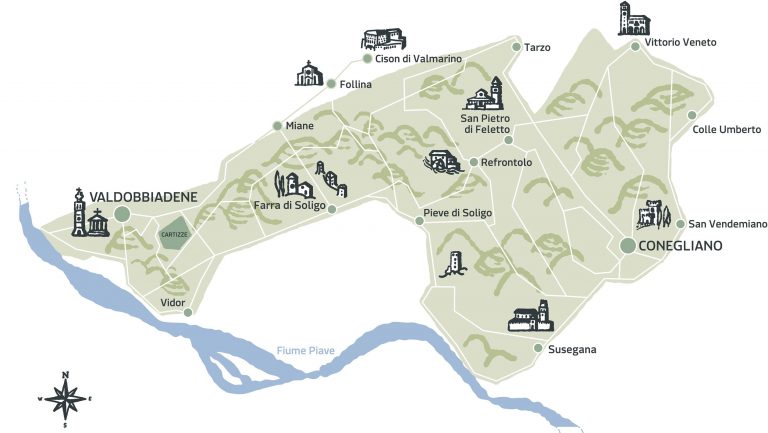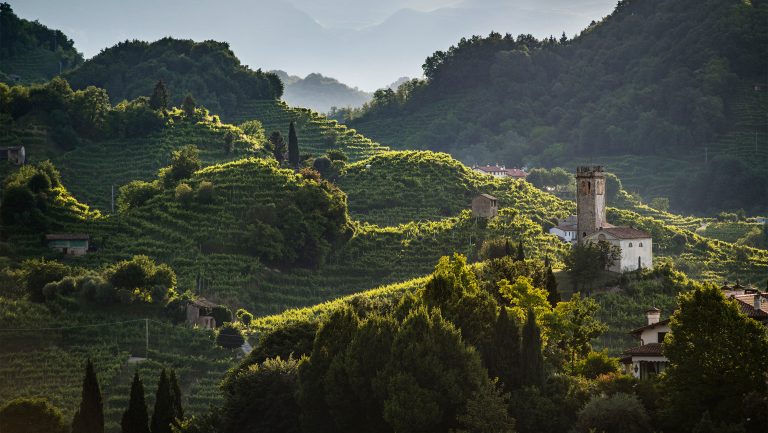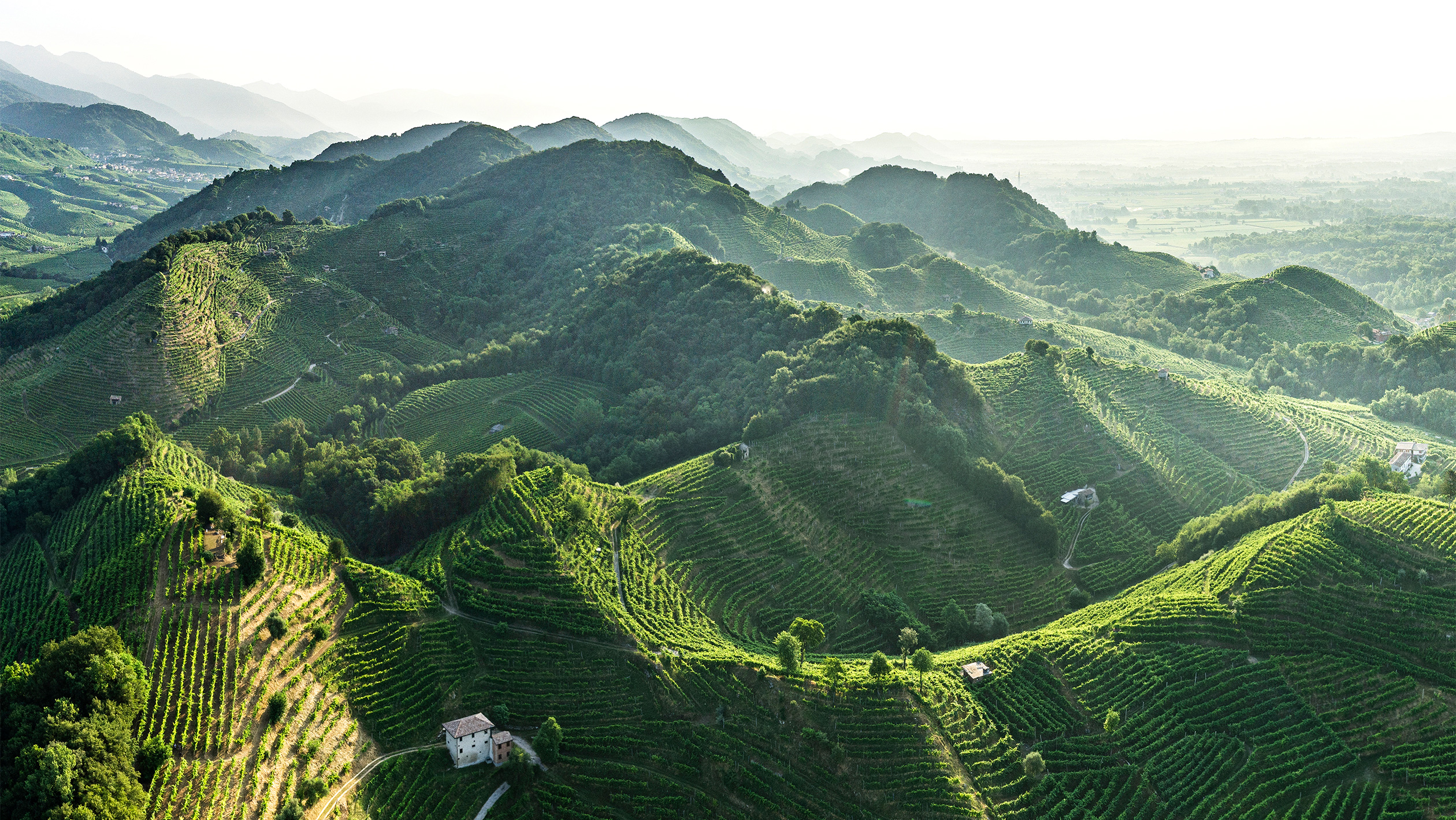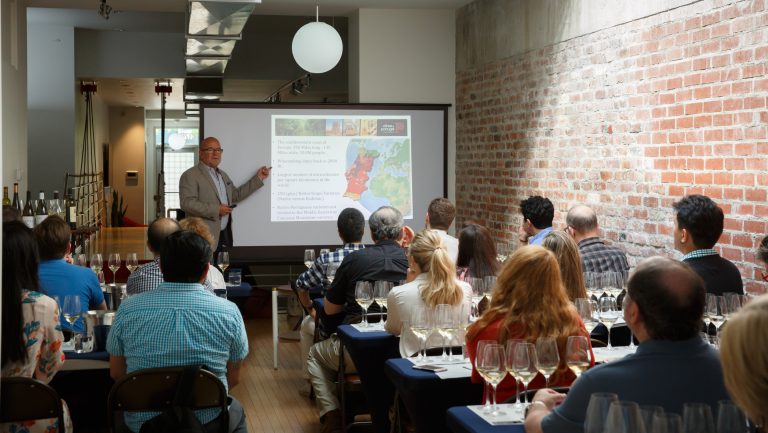This advertising content was produced in collaboration with our partner, Conegliano Valdobbiadene.
Across Conegliano Valdobbiadene Prosecco Superiore DOCG, Prosecco’s top-tier sparkling wine designation, the vine-covered hillsides conceal one of the secrets behind this Italian appellation: the soil.
While vintners around the globe will rhapsodize about their soils, the ground in Conegliano Valdobbiadene is extraordinary. Formed by the simultaneous upward push of the African continent and glacial flows, the most historic area for Prosecco production sits atop a checkerboard of rocky soil types in a “goldilocks” climate—ideal for producing the highly aromatic, effervescent wines that define the region.
“There is not one specific soil that yields better quality of wine, but it’s this variety and complexity that’s valuable to our region,” explains Dr. Diego Tomasi, a local agronomist and coauthor of the book The Terroirs of Conegliano Valdobbiadene Prosecco Wines. The work of Tomasi and researcher Federica Gaiotti examines the particular elements of the region, exposing in modern scientific terms what locals have known for generations—Conegliano Valdobbiadene’s one-of-a-kind topography and soils are uniquely suited to producing an incredible array of sparkling wines.

Don’t miss the latest drinks industry news and insights. Sign up for our award-winning newsletters and get insider intel, resources, and trends delivered to your inbox every week.
A Unique Combination of Soil and Sun
“Sometimes the morphology is more important than the soil, and sometimes it’s the opposite,” says Tomasi, referring to the intricate balance between the underground ecosystem of Conegliano Valdobbiadene and its climate. Nestled between the towering Dolomites and azure Adriatic Sea, the appellation lies in a pocket protected from extreme weather yet exposed to a wide range of temperatures.
Further complicating the pastoral landscape is an uncommon geological formation known as the “hogback,” a series of steep, east-west slopes interspersed with narrow parallel valleys. With slopes up to 70 percent, these steep sections of the appellation experience distinct weather patterns, which led the entire area to be named a UNESCO world heritage site in 2019.
These unique features have made Conegliano Valdobbiadene the dynamic heartland of Prosecco. In fact, renewed focus on the terroir led the region to officially recognize 15 communes in 1969, allowing vintners to differentiate their wines based on terroir specificity and quality in an increasingly crowded marketplace.
The Science of the Soils
The inherent complexity of Conegliano Valdobbiadene Prosecco Superiore is formed by the area’s complex underground soil ecosystems, which dictate the metabolism of each grapevine.
“We always have to examine the soils in relation to the amount of water and mineral nutrients that the vines can can find,” says Tomasi, who notes that as the vines struggle and adapt in each microclimate, their berries develop varying levels of aromatic compounds from the soils. “This is the reason there are different aromatic compounds in the finished wines,” he says.
The area’s five signature soil types—glacial-based morainic, iron-rich feletti, rocky conglomerate soils, clay marls, and Cartizze limestone—each possess different water retention capacities, organic nutrients, and friable topsoils which combine to form the backbone of their respective wines, even before vintage conditions such as rainfall and temperature come into play.
The soils with good drainage, like the morainic soils near appellation’s eastern edge and rocky, conglomerate soils along much of the hogback, yield grapes with high concentrations of benzenoids and norisoprenoids, the compounds responsible for spiciness and ripe fruit aromas in wine.
“In conglomerate soil areas, we have great aromas which are related to warm temperatures like norisoprenoids and also the monoterpenes,” says Gaiotti, Tomasi’s co-author. “That means that these grapes are rich in notes of ripe fruit and tropical fruit. It’s not that these compounds don’t exist in other wines, but they are more evident in these wines.”
The nuances between the fruit-driven wines made from vineyards on conglomerate soils and their neighbors emerge as a result of topographical and underground nuances.
“As you move through the appellation or toward Venice, the morphology changes. That means also different temperatures, and also different soil temperatures,” says Tomasi. “In feletti-dominated areas, the soil temperature is lower. So you can understand that the roots’ metabolisms are totally different.”
This cool, water-holding soil series that surrounds the appellation’s namesake village of Conegliano results in wines high only in the ripe-fruit compound norisoprenoids, which is why finished Proseccos from this area are known for their lively, vibrant fruit notes ranging from green apple to fresh citrus and honeyed tones.
Surrounding the village of Valdobbiadene, on the western edge of the appellation, thick, clay-dominant marl soils lend the vines an aromatic complexity that’s highly different from its neighbors. High water retention in the soils leads to the production of benzenoids, monoterpenes, and norisoprenoids, resulting in wines that fuse balsamic characteristics with bright fruit and floral tones.
The most unique soils, however lie over Conegliano Valdobbiadene’s “Grand Cru” village of Cartizze, where limestone deposits—not unlike those of Champagne’s most fabled terroirs—combine with marls to yield highly aromatic and elegant wines. Here, soils based on ancient marine deposits allow for rapid drainage, yet retain enough moisture to prevent hydric stress.
“The wines of Cartizze are more elegant compared to those grown on other soils,” says Tomasi. “Most likely, it’s because the calcareous soils have some effect on the metabolism of the plant, resulting in plants that promote the synthesis of aromatic compounds.”

Marrying Friendliness and Sophistication
Because the wines of Conegliano Valdobbiadene are always based on the native Glera variety, these bottlings provide a crystal clear lens onto the region’s legendary terroirs. With vivid freshness redolent of the verdant hillside terroir, these wines offer far more sophistication than their mass-market peers.
Today, wines labeled with the Prosecco Superiore Rive DOCG or Superiore di Cartizze DOCG make it easy to discover terroir-driven and specific bottlings from the area. Vintners producing singular expressions of their terroir which are from one of 43 designated communes can opt to label their vintage-dated wines Prosecco Superiore Rive DOCG, indicating the specific commune of origin on the label. Superiore Rive wines must showcase the steep hillsides that inspired the appellation’s UNESCO designation in these designated communes. Similarly, small growers in Cartizze may opt to label their wines Superiore di Cartizze DOCG—the pinnacle of Prosecco quality—if the grapes are grown entirely within the 108-hectare commune.
Conegliano Valdobbiadene’s commune-driven labeling updates may sound Burgundian, and that’s on purpose. “The microclimate has a very important role in the quality of the wine,” says Tomasi. “Similar to Burgundy, where they’ve divided the area into more than 1200 climats, we’ve been dividing our terroirs further. Now we have just 43 rive, but perhaps in the future we may be able to designate 200 or 300 different areas.”
Conegliano Valdobbiadene’s near-infinite terroir nuances combine to yield wines that are far more than just Prosecco—it’s no wonder “superiore” is part of its official name.

Dispatch
Sign up for our award-winning newsletter
Don’t miss the latest drinks industry news and insights—delivered to your inbox every week.










